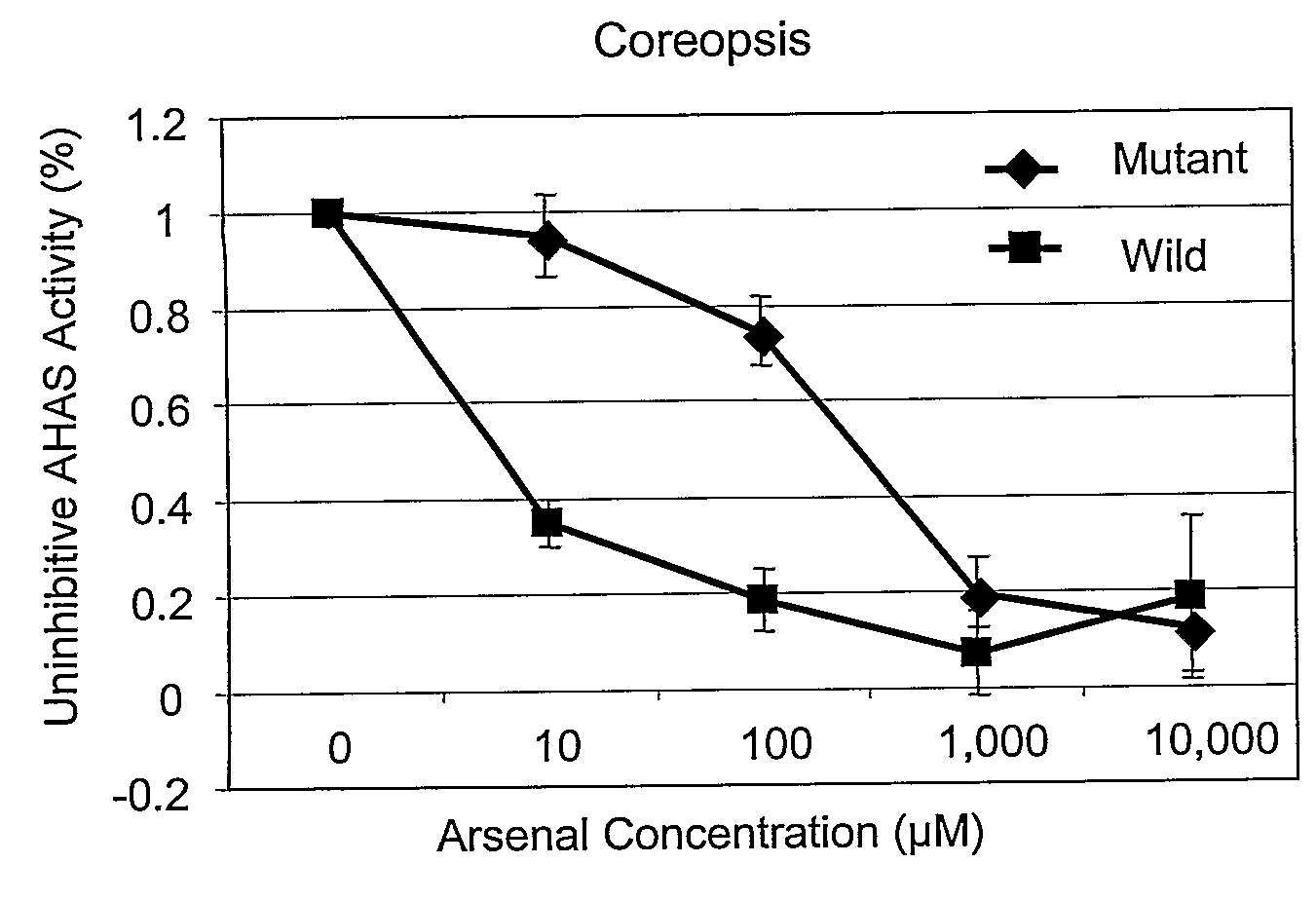Resistance to Acetolactate Synthase-Inhibiting Herbicides
- Summary
- Abstract
- Description
- Claims
- Application Information
AI Technical Summary
Benefits of technology
Problems solved by technology
Method used
Image
Examples
example 1
[0055]Plant materials: Herbicide susceptible (wild type) and resistant (mutant) strains of C. tinctoria, and susceptible Cocodrie rice (CCDR) and resistant CL161 rice varieties were used in this study. Seeds of Cocodrie rice, CL161 rice, and wild type C. tinctoria are available commercially.
[0056]To confirm herbicide resistance, and to characterize herbicide resistance profiles, seeds from the roadside-harvested, putatively-resistant Coreopsis were harvested (F0) and planted in a field in a separate location from the original roadside stand. The resulting F0 plants were not subjected to herbicide treatment. F1 seeds were harvested from the F0 plants, and the F1 seeds were planted in a field in several blocks and replicates. The resulting F1 plants were treated with various AHAS-inhibiting herbicides.
[0057]Commercial Coreopsis tinctoria seed were obtained as controls from two commercial nurseries. The commercially-obtained seed and the experimental seed were planted with a small grai...
example 2
[0067]Response of resistant and susceptible C. tinctoria to imidazolinone and sulfonylurea herbicides treatments: Both wild-type and mutant strains of C. tinctoria were planted in the greenhouse with ˜100 seeds per pot. Individual plants were transplanted to separate pots after seven weeks. The greenhouse regime comprised natural light with temperatures of 25 to 30° C. during the day and 15 to 20° C. at night. The experimental setup was a completely randomized design with five treatments and six plants (replications) per treatment for both wild-type and mutant strains. The five treatments were Arsenal (imazapyr), Oust (sulfometuron methyl), Arsenal+Oust sequential, Oust+Arsenal sequential, and control (no herbicide). Arsenal and Oust were applied with a back pack sprayer to individual mutant or susceptible, 14-week plants at rates of 8 oz. active ingredient / Acre rate and 2 oz. a.i. / A, respectively, with 12 plants per each herbicide treatment for both wild-type and mutants. Ten days ...
example 3
[0068]ALS enzyme Assay: An ALS enzyme assay was used to determine if resistance in the mutants was due to the ALS enzyme itself in the mutant plants. A modification was used of the colorimetric method of Singh B. K., Stidham M. A., and Shaner D. L. 1988. Assay of acetohydroxyacid synthase. Analytical Biochemistry 171:173-179. Rice plants were used as controls. Sulfometuron methyl (Oust), chlorsulfuron (Glean), and imazapyr (Arsenal) were used as ALS inhibitors. Briefly, 10 grams of young leaves pooled from either mutant plants or from susceptible plants were ground to a powder in liquid nitrogen, and mixed with 50 ml of extraction buffer containing 100 mM K2HPO4 (pH 7.5), 10 mM sodium pyruvate, 5 mM EDTA, 1 mM valine, 1 mM leucine, 10 mM cysteine, 0.1 mM flavin adenine dinucleotide, 5 mM MgCl2, 10% (v / v) glycerol, and 1% (w / v) polyvinylpyrrolidone. The homogenate was filtered through eight layers of cheesecloth and centrifuged at 25,000 g at 4° C. for 20 min. The supernatant was bro...
PUM
| Property | Measurement | Unit |
|---|---|---|
| Fraction | aaaaa | aaaaa |
| Electrical conductance | aaaaa | aaaaa |
| Volume | aaaaa | aaaaa |
Abstract
Description
Claims
Application Information
 Login to View More
Login to View More - R&D
- Intellectual Property
- Life Sciences
- Materials
- Tech Scout
- Unparalleled Data Quality
- Higher Quality Content
- 60% Fewer Hallucinations
Browse by: Latest US Patents, China's latest patents, Technical Efficacy Thesaurus, Application Domain, Technology Topic, Popular Technical Reports.
© 2025 PatSnap. All rights reserved.Legal|Privacy policy|Modern Slavery Act Transparency Statement|Sitemap|About US| Contact US: help@patsnap.com



